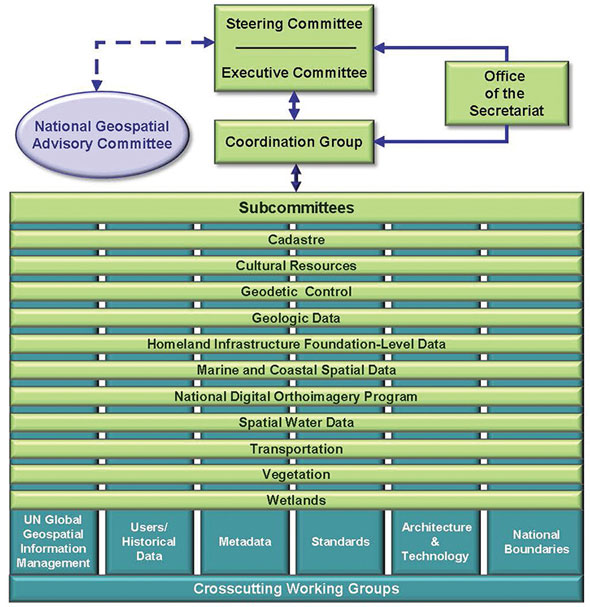The Federal Geographic Data Committee (FGDC) operates under Office of Management and Budget (OMB) Circular A–16 (revised August 2002). The circular incorporates Executive Order 12906 and reaffirms the FGDC’s role to provide leadership for the National Spatial Data Infrastructure (NSDI) and to coordinate the development, use, sharing, and dissemination of the Nation’s geospatial data. Close coordination among the many agencies involved in Federal geospatial activities helps ensure the efficient and effective investment and use of geospatial resources.
The FGDC is an organized structure of Federal geospatial professionals and constituents that provide executive, managerial, and advisory direction and oversight for geospatial decisions and initiatives across the Federal Government. In accordance with OMB Circular A–16, the FGDC is chaired by the Secretary of the Interior or his/her designee, and the OMB Deputy Director for Management or his/her designee serves as Vice Chair.
FGDC Structure
The FGDC is governed by a Steering Committee that sets the FGDC’s high-level strategic direction and is the Federal decision-making body. The Executive Committee, which is a subset of the Steering Committee, provides advice and guidance to the Chair and the Vice Chair.
The National Geospatial Advisory Committee (NGAC) is a Federal advisory committee that provides advice and recommendations on Federal and national geospatial programs. The FGDC Coordination Group consists primarily of geospatial program leads and technical experts and conducts the FGDC’s day-to-day business. The FGDC Office of the Secretariat, which is located at the U.S. Geological Survey headquarters in Reston, Virginia, provides strategic support and management for FGDC committees, components, and initiatives.
The FGDC infrastructure also includes agency-led subcommittees and working groups, and collaborating partners that represent State, Tribal, and local governments, as well as industry and academic and professional organizations. All participants initiate and (or) support the following activities that are crucial to expanding the NSDI and addressing national priorities:
- Providing advice and leadership in applying geospatial capabilities to address national priorities and Presidential initiatives.
- Developing and establishing the National Geospatial Data Clearinghouse on the Internet.
- Developing and implementing standards.
- Creating a national digital geospatial data framework.
- Promoting collaborative relationships for sharing geospatial data among and between Federal and non-Federal partners.
- Developing policies and processes to better harmonize collective action.
In addition, the Global Geospatial Management Working Group serves as the lead to develop and provide the United States’ position on topics addressed by the United Nations Committee on Global Geospatial Information Management (GGIM). More information about the FGDC structure and specific membership can be found at www.fgdc.gov/participation.

Chart showing the structure of the Federal Geographic Data Committee.
Steering Committee
The FGDC is governed by the Steering Committee, which is the policy-level interagency group whose central focus is to provide executive leadership for the coordination of Federal geospatial activities between, among, and within agencies. The committee does this by establishing policy and providing guidance and direction to the member agencies, based on business best practices. The Steering Committee is responsible for overseeing activities related to OMB Circular A–16 and for the implementation of the National Spatial Data Infrastructure. The FGDC Chair and Vice Chair lead the committee, which is made up of senior agency officials for geospatial information (SAOGIs) and includes representatives from Federal organizations, including the Executive Office of the President, Federal Executive Departments, and independent Federal agencies.
A subset of the Steering Committee, the Executive Committee, provides advice and guidance to the FGDC Chair and the Vice Chair on major Federal geospatial priorities and initiatives. The FGDC Chair and Vice Chair lead this committee, which includes representatives from the OMB and the seven Federal agencies that have the largest investments in geospatial technologies. The Executive Committee makes recommendations to the Steering Committee and provides a focal point for coordination with the National Geospatial Advisory Committee.
| 2015 Steering Committee Agencies | ||
|---|---|---|
|
Federal Communications Commission (non-voting member) |
||
|
General Services Administration |
||
|
Library of Congress |
||
|
National Aeronautics and Space Administration |
||
|
National Archives and Records Administration |
||
|
National Capital Planning Commission (non-voting member) |
||
|
National Science Foundation |
||
|
Office of Management and Budget (tie-breaking vote only) |
||
|
Office of Personnel Management |
||
|
Small Business Administration |
||
|
Smithsonian Institution |
||
|
Social Security Administration |
||
|
Tennessee Valley Authority |
||
|
U.S. Agency for International Development |
||
|
U.S. Army Corps of Engineers (non-voting member) |
||
|
U.S. Department of Agriculture |
||
|
U.S. Department of Commerce |
||
|
U.S. Department of Defense |
||
|
U.S. Department of Education |
||
|
U.S. Department of Energy |
||
|
U.S. Department of Health and Human Services |
||
|
U.S. Department of Homeland Security |
||
|
U.S. Department of Housing and Urban Development |
||
|
U.S. Department of the Interior |
||
|
U.S. Department of Justice |
||
|
U.S. Department of Labor |
||
|
U.S. Department of State |
||
|
U.S. Department of Transportation |
||
|
U.S. Department of the Treasury |
||
|
U.S. Department of Veterans Affairs |
||
|
U.S. Environmental Protection Agency |
||
|
U.S. Nuclear Regulatory Commission |
||
Appendix B

